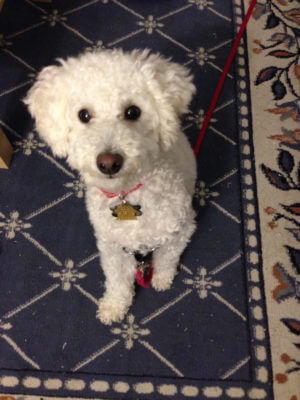Meet Teddy!
Teddy is a one-year-old Poodle mix. His parents have been concerned about Teddy’s barking at the door in their apartment building, and they called Zen Dog Training for some help!
Teddy greeted us as he would ANY stranger in his home: with a lot of barking!
The Drag Leash
Before our arrival, we instructed Dan to keep a Drag Line on him (a leash already attached to his collar that drags on the floor) in case we needed to interrupt Teddy if he wouldn’t listen.
As soon as we walked in the door, Teddy was fixated and barking non-stop at us. We instructed Dan to interrupt his barking by using the leash to move Teddy’s body around (a 180-degree turn). “Don’t let him see us”, Gordon instructed. The eye contact continued, as well as Teddy’s barking!
Finally, when Dan used the leash to walk Teddy all the way around the corner and into the kitchen — the eye contact was broken and the barking stopped.
“Ask, Ask, Tell”
Using the leash to interrupt unwanted behaviors is an important step. However, it’s usually not the first step. At Zen Dog Training we teach “Ask, Ask, Tell”.
Teaching Teddy to stop barking meant setting up situations where we could reinforce our rules. Dan and Susan took turns asking Teddy for attention while Gordon played different “stranger” roles at the apartment door. Gordon would pretend to be a visitor opening the front door. Dan would call him away from the door, “Teddy”, while Teddy barked. He would ask again, “Teddy!”
At first, Teddy was so worked up the Ask Strategy didn’t work. He was in no place to listen. In fact, not only would he not come when called, he wouldn’t even turn his head away. Since Teddy couldn’t listen in such a high-stress environment. We moved to a Tell Strategy, (a.k.a. Interrupting)
How to Interrupt Barking at the Front Door:
- Say “Uh-Uhh!” – this signals your disapproval.
- Walk over to your dog and grab the handle of the leash (Drag Line).*
- Interrupt your dog — Use the leash to break eye-contact with whatever has your dog upset by turning his head and body 180-degrees around.
- Gently but firmly walk your dog away from the door.
*Remember: When your dog is misbehaving, having them wear an indoor leash (“Drag Line”) is important! This way you can grab the handle of the leash and not always grab their collar when your dog is acting up.
Once you walk your dog away, you can manage the situation by putting your dog in his confinement area, tethering, or crating him. Ideally, if you have the time, you can make it a training moment.
Training Moments:
We decided to make it a training moment and took 10 minutes to practice teaching Teddy to stop barking at the door.
People knocked on the door and entered the house several times in a row. At first we had to interrupt him every time someone knocked. After a few reps, Teddy began to look back at Dan instead of barking non-stop. Dan and Susan said, “Yes! Good boy!” and rewarded the pause in his barking with treats and praise.
After several breaks and another 10 minutes of training, Teddy was actually coming away from the door instead of barking his head off!
Because Teddy had learned over months to react and impulsively bark when frightened by the door, at first we had to use the Drag Line to “Tell” him to move away from the door. However, with consistent practice over 3-5 weeks, Teddy began to listen when he was simply “Asked” to stop barking at the door.
To learn more about Solving Problem Behaviors, Ask Strategies, Interrupting and Managing, check out Zen Dog Training Online!

